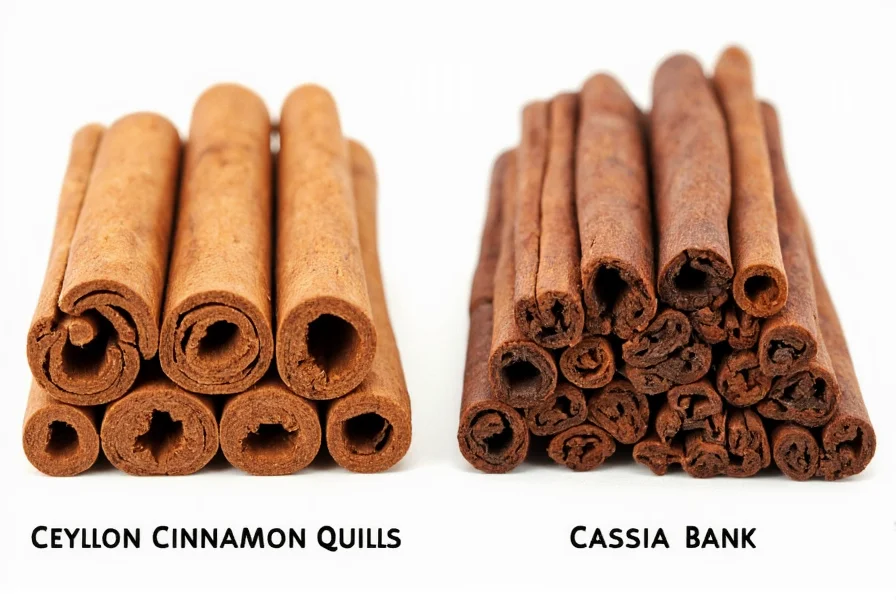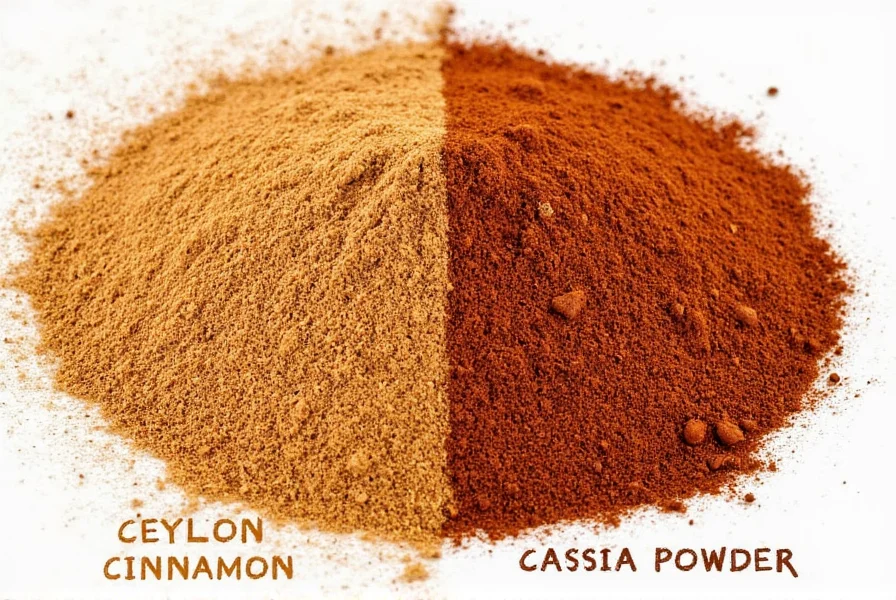When you reach for that spice jar labeled \'cinnamon,\' you might actually be grabbing cassia bark without realizing it. This common confusion stems from marketing practices where cassia—cheaper and more widely available—is often sold simply as \'cinnamon\' in many countries, particularly the United States. Understanding the distinction between cassia bark vs cinnamon (true Ceylon variety) matters for both culinary precision and health considerations.
Botanical Origins and Global Production
Cassia bark and true cinnamon come from different species within the Cinnamomum genus. Ceylon cinnamon (Cinnamomum verum) originates from Sri Lanka and southern India, representing only about 10-20% of global cinnamon production. Cassia (Cinnamomum cassia), sometimes called Chinese cinnamon, accounts for the majority of \'cinnamon\' sold worldwide, primarily grown in China, Indonesia, and Vietnam.
Other varieties exist too, including Saigon cinnamon (Cinnamomum loureiroi) from Vietnam and Korintje cinnamon from Indonesia, but these are technically cassia types with even higher coumarin levels than standard cassia.
Physical and Sensory Differences
Telling these spices apart requires attention to detail. Ceylon cinnamon sticks form multiple thin, papery layers that create a tight, delicate scroll. Cassia bark, by contrast, forms a single thick, rigid quill that's difficult to break. When ground, Ceylon cinnamon has a lighter tan color compared to cassia's deeper reddish-brown hue.
Flavor profiles differ significantly. Ceylon offers a subtle, sweet, citrusy flavor with delicate complexity, while cassia delivers a stronger, spicier, more pungent taste that can border on bitter when used excessively. Professional chefs often prefer Ceylon for desserts and delicate dishes, reserving cassia for robust recipes like chai or barbecue rubs where its intense flavor can shine.
| Characteristic | Ceylon Cinnamon (True Cinnamon) | Cassia Bark |
|---|---|---|
| Scientific Name | Cinnamomum verum | Cinnamomum cassia |
| Origin | Sri Lanka, India | China, Indonesia, Vietnam |
| Bark Structure | Multiple thin layers, soft and crumbly | Single thick layer, hard and dense |
| Coumarin Content | Approximately 0.04g/kg | Approximately 3-13g/kg |
| Flavor Profile | Mild, sweet, citrus notes | Strong, spicy, slightly bitter |
| Price Comparison | 5-10x more expensive than cassia | More affordable, widely available |
Health Implications: The Coumarin Factor
The most critical difference between cassia bark vs cinnamon involves coumarin content. Coumarin, a natural compound found in higher concentrations in cassia, can cause liver toxicity when consumed in large amounts over time. The European Food Safety Authority recommends a maximum daily intake of 0.1mg coumarin per kilogram of body weight.
Just one teaspoon of cassia contains enough coumarin to exceed this limit for most adults, while Ceylon cinnamon contains negligible amounts. This makes Ceylon the safer choice for regular consumption, especially for children, people with liver conditions, or those taking medications metabolized by the liver.
Both varieties offer potential health benefits including antioxidant properties and blood sugar regulation effects, but research suggests these benefits come with less risk when using Ceylon due to its minimal coumarin content.

Culinary Applications and Substitution Guidelines
Understanding when to use cassia bark vs cinnamon can transform your cooking. Ceylon's delicate flavor works best in dishes where cinnamon should be noticeable but not overwhelming—think custards, fruit compotes, and delicate baked goods. Its subtle sweetness complements dairy-based desserts without competing with other flavors.
Cassia's robust profile shines in recipes that benefit from bold spice notes: mulled wines, hearty stews, spice blends like garam masala, and Middle Eastern dishes. When substituting between the two, use approximately half the amount of cassia when replacing Ceylon to avoid overpowering your dish.
Professional bakers often maintain both varieties in their pantries, selecting based on the specific requirements of each recipe. For everyday use, especially in households with children or health concerns, Ceylon provides peace of mind regarding coumarin exposure.
How to Identify What You're Buying
Reading labels carefully is essential when distinguishing cassia bark vs cinnamon. In the United States, most supermarket \'cinnamon\' is actually cassia. Look for specific labeling like \'Ceylon cinnamon,\' \'true cinnamon,\' or \'Mexican cinnamon\' (which usually indicates Ceylon).
Price provides another clue—authentic Ceylon cinnamon typically costs significantly more than standard cinnamon. Specialty spice shops, international markets (particularly Latin American or Sri Lankan stores), and reputable online spice merchants offer the best chances of finding genuine Ceylon cinnamon.

Making an Informed Choice
When considering cassia bark vs cinnamon for your kitchen, balance flavor preferences with health considerations. For occasional use in robust recipes, cassia remains a perfectly acceptable option. For daily consumption, children's foods, or if you have liver concerns, investing in Ceylon cinnamon provides significant health advantages.
The growing awareness of these differences has led to increased availability of true cinnamon in mainstream markets. As consumers become more educated about the distinction between cassia bark vs cinnamon, manufacturers are responding with clearer labeling practices—though vigilance remains necessary when making your selection.
Frequently Asked Questions
Is cassia bark the same as cinnamon?
No, cassia bark and true cinnamon (Ceylon cinnamon) come from different tree species. While cassia is often labeled simply as \'cinnamon\' in the United States, it's actually a different variety with distinct flavor, appearance, and chemical composition—particularly higher coumarin levels.
Which is healthier: cassia or true cinnamon?
Ceylon cinnamon (true cinnamon) is generally considered healthier for regular consumption because it contains significantly lower levels of coumarin—a compound that can cause liver damage in high amounts. While both varieties offer antioxidant benefits, Ceylon provides these benefits with minimal coumarin exposure.
How can I tell if my cinnamon is cassia or Ceylon?
Examine the cinnamon sticks: Ceylon forms multiple thin, papery layers that crumble easily, while cassia creates a single thick, hard quill. Ground Ceylon is lighter tan, while cassia is darker reddish-brown. Check labels for \'Ceylon\' or \'true cinnamon\'—most standard supermarket \'cinnamon\' is actually cassia, especially in the United States.
Can I substitute cassia for cinnamon in recipes?
Yes, but with adjustments. Cassia has a stronger, spicier flavor than Ceylon cinnamon, so use about half the amount of cassia when substituting for Ceylon. For delicate recipes like custards or light baked goods, Ceylon works better, while cassia suits robust dishes like stews or mulled beverages where its intense flavor can shine.
Why does coumarin content matter in cinnamon?
Coumarin, found in high concentrations in cassia bark, can cause liver toxicity when consumed in large amounts over time. The European Food Safety Authority recommends limiting intake to 0.1mg per kilogram of body weight daily. Just one teaspoon of cassia may exceed this limit, while Ceylon cinnamon contains negligible amounts, making it safer for regular consumption.










 浙公网安备
33010002000092号
浙公网安备
33010002000092号 浙B2-20120091-4
浙B2-20120091-4